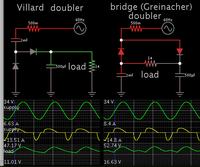Enzy
Advanced Member level 1
I want to power a Dc motor it ranges are 0-180v 2.3AMPS I have a 10 Amp 12-0-12V transformer I added a rectifier and connected it to the motor and it worked but I am getting between 1.7 and 2 amps current draw with no load, IT runs a conveyor and its a small geared motor I am wondering if its because I am only using 24v to power the motor why the amp range is so high or is there another simple schematic I can use to power it so that the current draw isnt that high.

